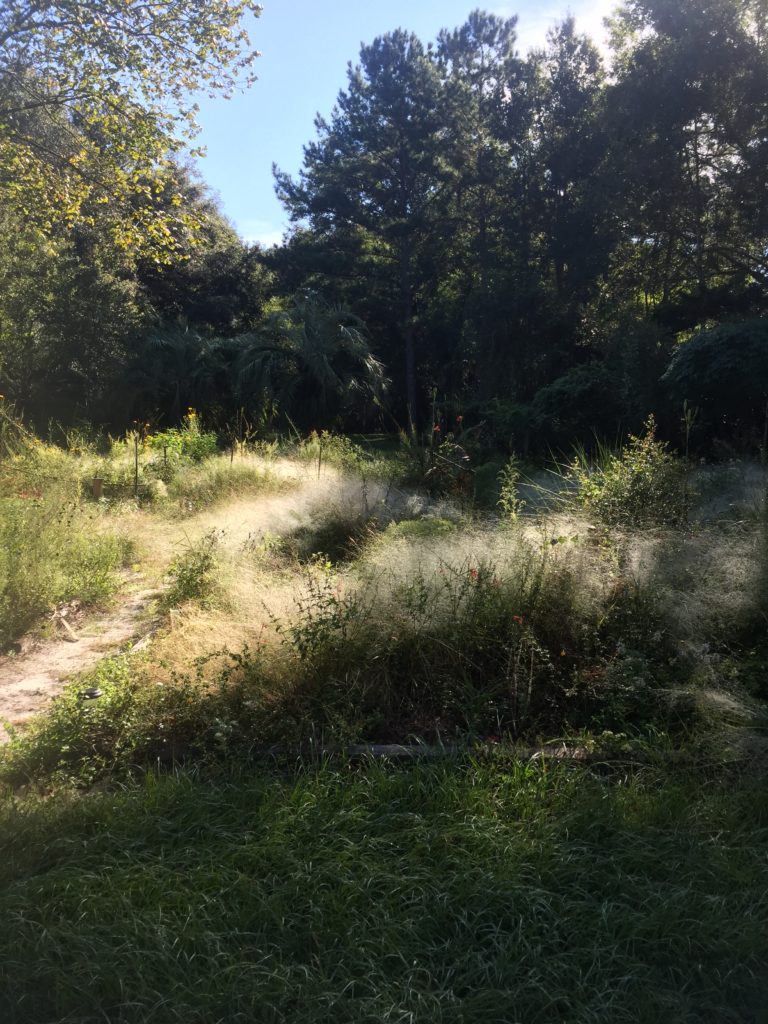My spooky wildflower garden
by Claudia Larsen
October started with a beautiful full moon, and in those hours I can’t sleep, I look out the upstairs window over my dappled moonlit wildflower garden. It looks serene and scary at the same time.
In daylight, the garden is revealed as an overgrown work of art as the summer plants have reached mature stages and gently lean on each other for support. I see tall goldenrod, some in full bloom and others gone to seed, nodding their passing with rusty terminal panicles. They are surrounded by bushy Bluecurls (Trichostema dichotomum), whose glorious small flowers, like small blue clouds floating above the ground, wait for fall to appear. Clumps of 5-foot Frostweed (Verbesina virginica), with their bright white flowerheads, stand on both sides of the garden’s entrance like ghosts beckoning me to enter with care.
Purple lovegrass (Eragrostis spectabilis), which politely filled the garden space between wildflowers, has exploded into bloom, tripling in size and obscuring smaller wildflowers like Cutleaf coneflower (Rudbeckia laciniata), Helmet skullcap (Scutellaria integrifolia), and Greeneyes (Berlandiera subacaulis). The grasses also thankfully cover all those pesky weeds and grasses I have neglected to weed in the sweat drenching summer days!

Large 5-foot Giant ironweed (Vernonia gigantea) bloomed for August butterflies and now stands like stick-figure scarecrows, towering over salvias and Rattlesnakemaster (Eryngium yuccifolium), which, with their spiky round flowerheads, themselves look like unearthly medieval torture instruments. They are interspersed with Rayless sunflower (Helianthus radula), which for no fault of their own are not blessed with colorful yellow petals like their Swamp sunflower (Helianthus angustifolius) cousins. Why did Mother Nature curse them?
There are long black seedpods hanging on my Partridge peas (Chamaecrista fasciculata) – will they split to release a scary small creature that will inhabit my garden? No, thank goodness, probably just those black seeds that line up like pea pods to become next years progeny.
Here in Micanopy my garden is still haunted by mosquitos of various sizes – all tiny Draculas – waiting for my blood. I run down the garden path trying to reach the garden shed, but I am enveloped by that tiny buzzing that hums my fate. They might as well be the Baskerville hounds. I feel like a pro football player running an option to avoid all the 4-foot Spotted beebalm (Monarda punctata) that decided to live in my garden walkways instead of where I delicately planted them.
I hope you are also enjoying your October wildflower garden. Although it may not be as fresh and colorful as the spring garden, it is still full of fun and its own kind of spooky beauty.
Claudia Larsen is the Foundation’s Seeds for Schools program administrator. She owns Micanopy Wildflowers, a nursery in Micanopy.
